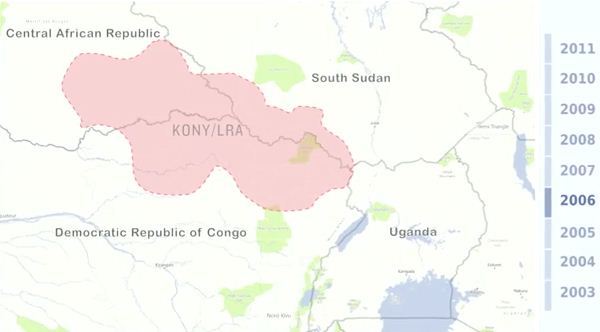While the morality of the LRA conflict is simple, its causes, history and proposed solutions are anything but. This page is stocked with resources to help you learn more about the Lord’s Resistance Army. This list may look overwhelming at first glance, but look through the headings and read the descriptions to find the topics you’re most interested in.
Understanding the LRA
Human Rights Watch: Frequently asked questions about Joseph Kony and the LRA (March 21, 2012). An introduction to the LRA conflict and the current circumstances. This is an ideal place to start building a historical framework.
Reports
Human Rights Watch: “DR Congo: Lord’s Resistance Army Rampage Kills 321” (Mar 2010). In December 2009, the LRA killed 321 people over the course of four days. Yet it wasn’t reported in Western media until three months later when Human Rights Watch released this report. The event was called the Makombo Massacre.
Justice and Reconciliation Project: Victims’ Voices: JRP Community Dialogues (2008). Published two years after the LRA left northern Uganda, this is a collection of interviews in Acholiland about reconciliation between perpetrators and victims. It talks about both the paths and obstacles to reintegration for former LRA in their home communities, with respect to Acholi culture and norms.
International Crisis Group: End Game (Nov 2011). This report highlights the current situation and solutions that have been proposed. Focusing on a comprehensive approach to apprehension, “End Game” provides thoughtful recommendations for governments and international bodies to improve efforts to protect civilians and end the LRA threat.
The Enough Project: “The Lord’s Resistance Army of Today” by Ledio Cakaj (Nov 2010). This report is a nuanced examination of the structure, history, and actions of the LRA. It is written with the premise that a deeper understanding of the group will allow for a more successful strategy in overcoming it.
The Enough Project: “‘This is our land Now’: Lord’s Resistance Army attacks in Bas Uele, Northeastern Congo” by Ledio Cakaj (Aug 2010). This report focuses on LRA activity outside of Uganda and looks at the involvement of MONUSCO and the FARDC (DR Congo’s military). It argues that the LRA has caused more damage in Congo than any other force.
Articles
The New Yorker: “Our Children Are Killing Us” by Elizabeth Rubin (Mar 1998). This article describes the LRA’s brutal method of abduction and indoctrination. Published in 1998, it serves as a reminder of how long these same atrocities have been taking place and how long people have been trying to end the violence.
Advocacy
Videos
Discover the Journey: “Let the World Know” (2011). Sister Giovanna is a Comboni nun who has lived in the LRA-affected region for more than 25 years–first in northern Uganda and now in South Sudan. Having witnessed the scale and horrific nature of the atrocities, she asks that the world be told about what is happening.
Human Rights Watch: “Dear President Obama: Letters from Victims of the LRA” (2010). Victims of the LRA ask President Obama to take “urgent and decisive” action against the LRA.
Videos produced by Invisible Children
Who is the LRA (2011). An overview of the LRA’s 26-year history, brutal tactics, and current activities.
Civil Leaders in CAR, DRC, and South Sudan speak on LRA violence (2012). Civil society leaders in the currently LRA-affected region talk about the ongoing violence and what it will take to stop it.
Makombo Massacre – December 14, 2009 (2011). Human Rights Watch’s Ida Sawyer talks about one of the LRA’s most brutal massacres in recent history. It took place in DR Congo from December 14-18, 2009, but because of the remote nature of the region, the news didn’t reach mainstream media until three months later.
Reports
Resolve: “Peace Can Be: President Obama’s Chance to Help End LRA Atrocities in 2012” by Paul Ronan (Feb 2012). Based on field research in the communities currently affected by the LRA, this report gives specific recommendations to the White House about protecting civilians, encouraging defections, and stopping LRA violence.
Human Rights Watch: “Declaration from the Dungu Workshop” (Nov 2011). This is a declaration of need and a list of recommendations for stopping the LRA. With support from Human Rights Watch, the workshop was hosted by Justice and Peace Commission of the Catholic Diocese of Dungu, civil society activists from CAR, DRC, Uganda and South Sudan, and other international actors.
Related materials on the LRA conflict and international justice
Books
King Leopold’s Ghost by Adam Hochschild (1999). This book is a history of the Congo–specifically the 1880s when Belgium’s King Leopold II “looted its rubber, brutalized its people, and ultimately slashed its population by ten million–all the while shrewdly cultivating his reputation as a great humanitarian.”
A Problem from Hell: America and the Age of Genocide by Samantha Power (2007). An examination of human rights crises in the second half of the 20th century and how the United States chose to act or not to act.
Dancing in the Glory of Monsters by Jason K. Stearns (2011). Further south in eastern DR Congo, Jason Stearns examines the history, root causes, and current conflict in the Kivus.
Articles
Human Rights Watch: “ICC: Landmark Verdict a Warning to Rights Abusers” (Mar 2012). An article about the first guilty verdict issued by the International Criminal Court (ICC). It stands as a warning and a symbol of the new level of accountability for international crimes.
Justice in Conflict: Thomas Kwoyelo Trial (Jul 2011- Feb 2012). A series of articles on former LRA commander, Thomas Kwoyelo. Nearly 13,000 former LRA have been granted amnesty under Uganda’s Amnesty Act of 2000. Kwoyelo was the first commander not to automatically receive amnesty. These articles track his trial in the Ugandan Courts. The final decision will have bearing on how other LRA commanders will be treated, legally. The decision will either encourage or disincentivize defection for LRA combatants.

Think people should hear about this?